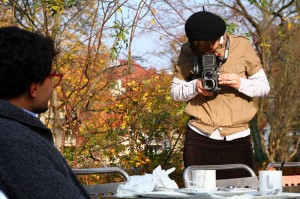
A group of ECLA students dedicated the weekend of November 5th and 6th to the Analogue Photography Workshop led by Joe Dilworth, a British photographer who currently works and lives in Berlin.
He showed us how to use ECLA’s darkroom along with the analogue cameras the College has bought in the course of the last years, both of which are always at the disposal of the students. We strolled through Pankow on an extraordinarily beautiful Saturday morning taking photographs and then, over the rest of the two-day workshop, spent many hours amidst all kinds of lamps and chemicals in the cosy atmosphere of complete darkness.
After gathering in the administration building, Joe introduced us to the basics of analogue photography. He taught us how aperture and shutter speed work in relationship with each other to create a correct exposure and we were able to practice this with the normal format cameras that use 35mm film, though each of them had small peculiarities that led us to use them differently.
On our way to brunch, we got the first opportunity to take our own pictures and fell in love with the charming old machines. We got the impression that working with actual film cannot be compared to the digital photography every one of us is so used to today. Composing a perfect picture becomes so much more important when you cannot directly see the outcome on a screen; every possible influence on the photograph has to be considered before pushing down the release.
After brunch, we took a walk through Pankow and up to Schönhausen Palace, and as we were to find out later, managed to take many impressive photographs of the neighbourhood.
The next day Joe had brought along a few of his personal medium format cameras that work with 120mm film, and which produce quadratic pictures; we all had the opportunity to try them out. After we used up all of the film, we made our way back to the darkroom, where for many of us, our first real-life encounter with film development began.
We found ourselves in complete darkness, winding up the film on spools, mixing all sorts of chemicals together and cautiously shaking cylindrical containers in order to equally spread the liquid across the film. We learned how developer, stop bath and fixer are used to develop the negatives on the film. We washed the negatives and hung them up to dry and eagerly waited for what was going to happen next.
The next step was to create contact sheets by directly placing the negative sheets on photographic paper and exposing them to light. The sheets of paper remained invisible until we used the same chemical solutions mentioned above to develop them.
Contact sheets showed small versions of the negatives of the photographs we took and allowed us to get a glimpse of what the final, printed results might look like. It was fascinating to see the details gradually develop on the paper after being put into contact with the first chemical in the tray. Now we could choose which pictures we wanted to print on a bigger sheet of paper. We felt quite proud of our own creations and everyone selected the photographs they liked most ?a difficult decision to make after these two days of creative work.
We placed the negatives in the enlarger, adjusted size and focus, and again used sheets of photographic paper exposed to light to print the final version of the photographs.
We developed, washed and dried the paper. Finally our images were created and it turned out that the workshop had resulted in many very extraordinary pieces of art. Thanks to Joe’s fantastic workshop, we are now able to process analogue photography on our own, from inserting film into the camera to drying the actual print. Many of us will definitely keep pursuing photographic projects in the future.
by Johanna Fürst (AY’12, Austria)
